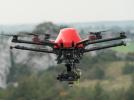Horizon DH8D near San Jose on Mar 5th 2013, persistent engine fire indication
A Horizon de Havilland Dash 8-400 on behalf of Alaska Airlines, registration N417QX performing flight QX-404/AS-2404 from San Jose,CA to Boise,ID (USA) with 47 passengers and 4 crew, was climbing through 17,000 feet out of San Jose when the crew stopped the climb declared emergency due to an engine (PW150A) fire indication. The engine was shut down, the fire suppression system activated, the fire indication persisted however. San Jose Airport cancelled a number of approach clearances in the meantime and kept both runways 12L/12R sterile. The crew did not acknowledge the hand off to San Jose approach, did not report on San Jose approach frequency even after San Jose approach called on guard, too, and was seen descend rapidly. Resulting in a noticeable relief for the controllers the crew checked in with San Jose tower, the crew audibly on oxygen masks reported they still had an active fire indication on the right hand engine, they were planning to evacuate after landing. The aircraft was cleared to land runway 12L or 12R on pilot's discretion, tower reported there was no smoke visible from the aircraft. The aircraft landed safely on runway 12L, stopped on the runway and shut down, emergency services reported seeing no smoke and no trace of fire, the aircraft was not evacuated. The passengers disembarked normally and were bussed to the terminal. The aircraft was towed to the apron about one hour after landing.
A replacement Dash 8-400 registration N438QX reached Boise with a delay of 6.5 hours.
On Mar 15th 2013 the NTSB reported the aircraft sustained minor damage as result of an inflight engine fire. The aircraft was climbing towards FL200 when the crew heard a bang and received a right hand engine fire indication. The right hand engine was shut down, both fire bottles were discharged however without success. Cabin crew reported no fire was visible from the engine. The aircraft returned to San Jose for a safe landing and stopped on the runway, the left engine was shut down and the passengers disembarked through the left main door. Initial assessment by maintenance confirmed an actual engine fire, the damage to the aircraft was limited to "what was visible on the aircraft's exterior". The aircraft was moved to a secured hangar for further examination.
On Oct 1st 2014 the NTSB released their final report concluding the probable cause of the incident was:
The failure and separation of a section of the No. 2 engine's combustion chamber's small exit duct (SED), which created an airflow disruption that led to an engine surge and subsequent fire. Contributing to the accident was the insufficient weld penetration that remained totally contained within the SED outer dome and did not penetrate through to the inner duct as required by the manufacturing specifications.
The NTSB reported that the engine's low pressure compressor, turbines, combustion chambers and gearboxes did not receive damage though downstream of the high pressure compressor sooting was visible. The NTSB described the damage to the high pressure compressor:
"The high pressure turbine (HPT) vane assembly includes the SED inner duct and outer dome that are welded together and function to direct combustion gas flow. Pieces of the outer dome had separated from the vane assembly and were subsequently ingested into the gas path. A section of the SED outer dome was submitted to the PWC materials lab for weld analysis. The exposed inner duct of the SED exhibited localized thermal distress including burn through and distortion at approximately the 11 O' Clock position. Sooting, metal splatter and discoloration were noted on all HPT vanes with some metallic fragments adhering to the leading edge of the vane airfoil. Two metal fragments were found resting at the bottom of the HPT blade shroud against the aft side of the vanes.
The HPT disk assembly exhibited impact damage and metal splatter along the blade leading edges 360 degrees around. All blades were heavily sooted. Material loss was noted on leading edge blade tips resulting in exposure of internal blade cooling passages. Uniform tip rubs were present on HPT blades around the disk as evidenced by shiny metal and material smearing."
http://avherald.com/h?article=45ec3f04














Komentarze